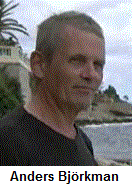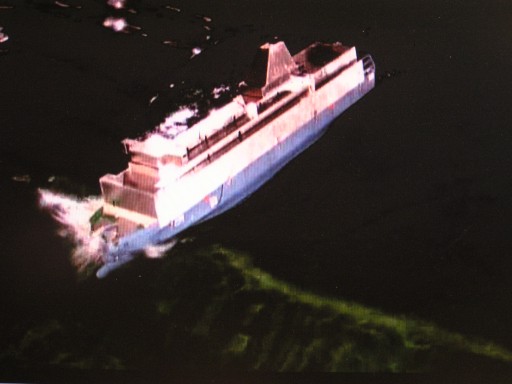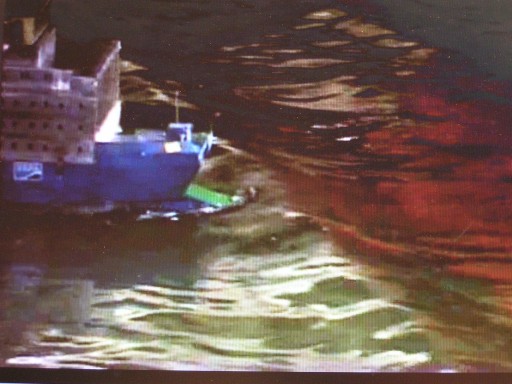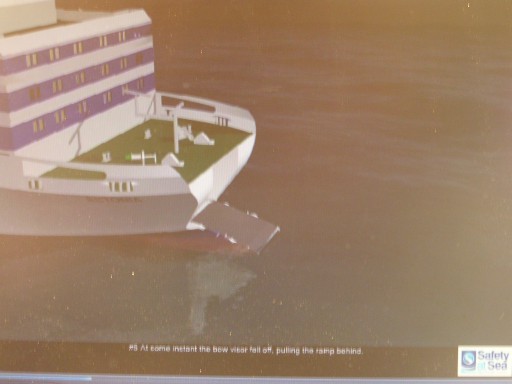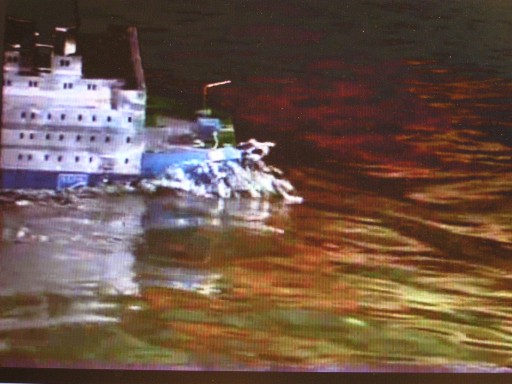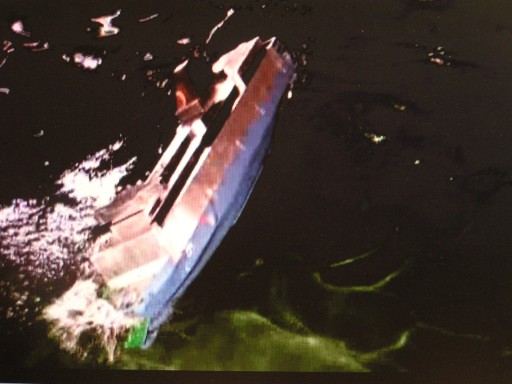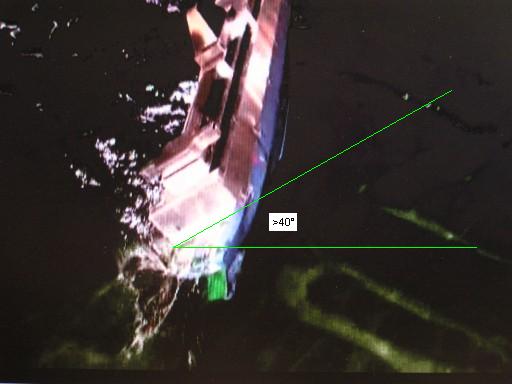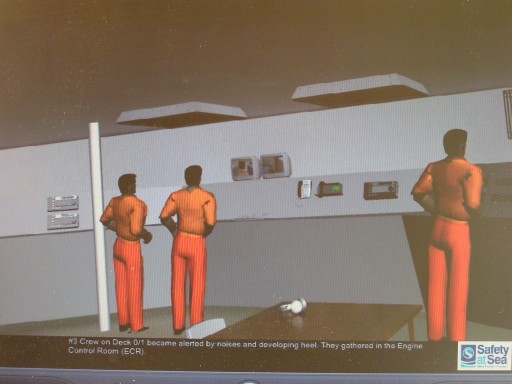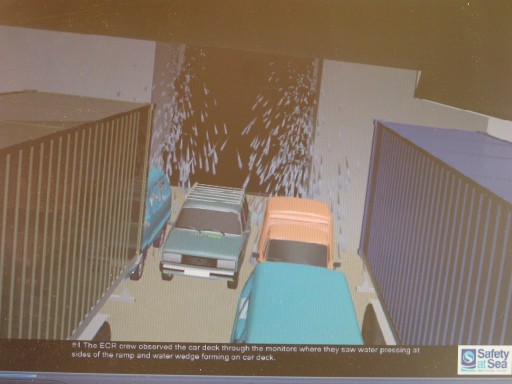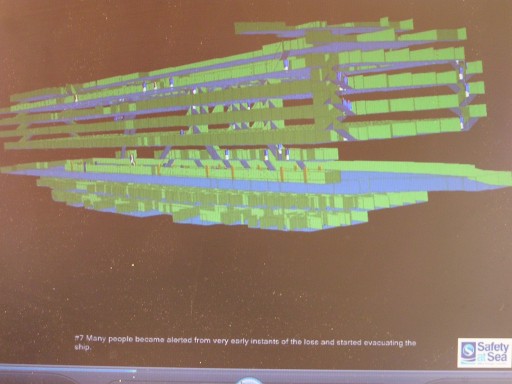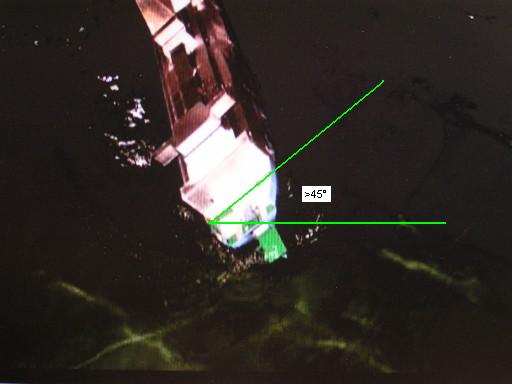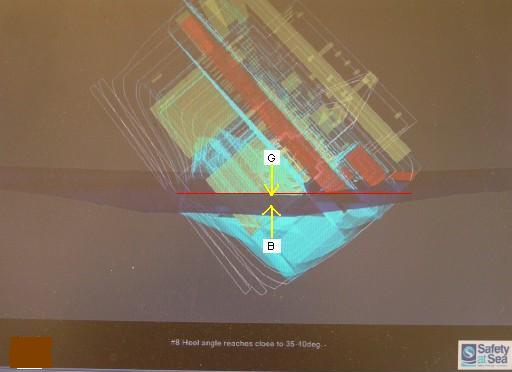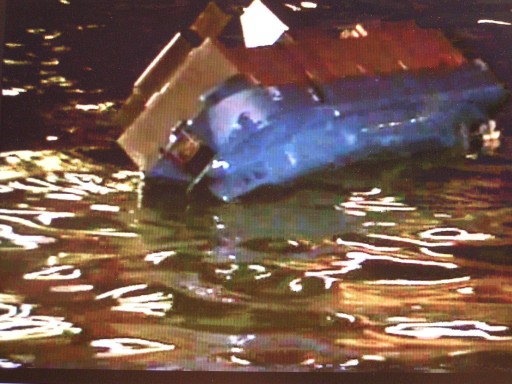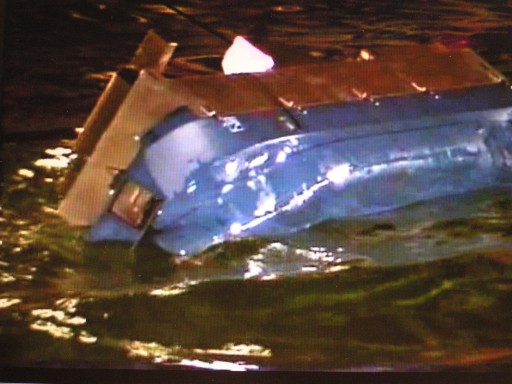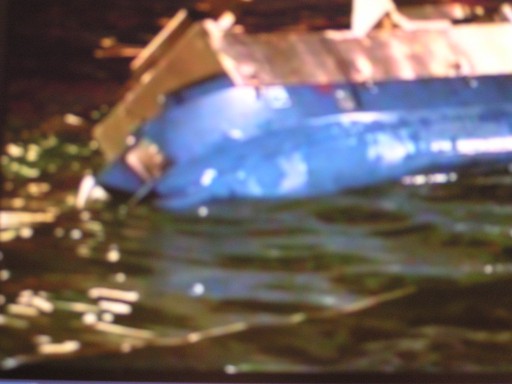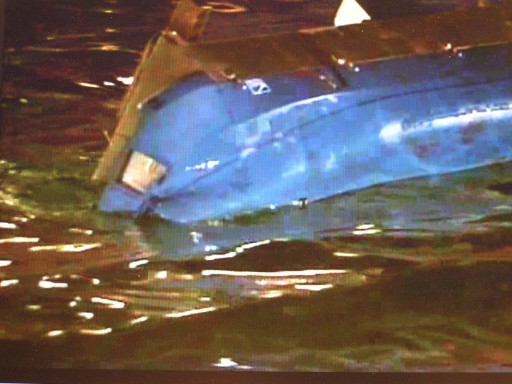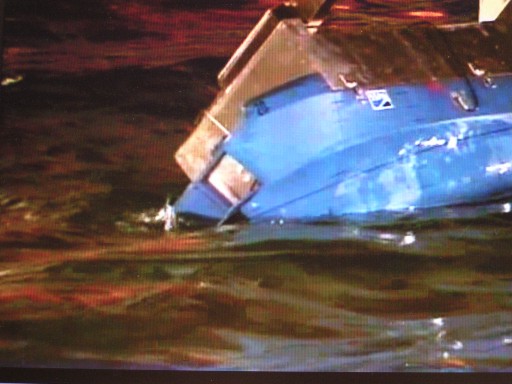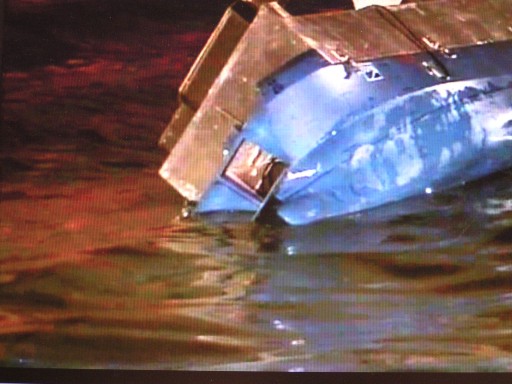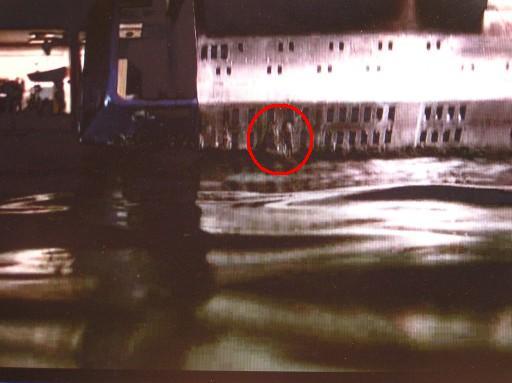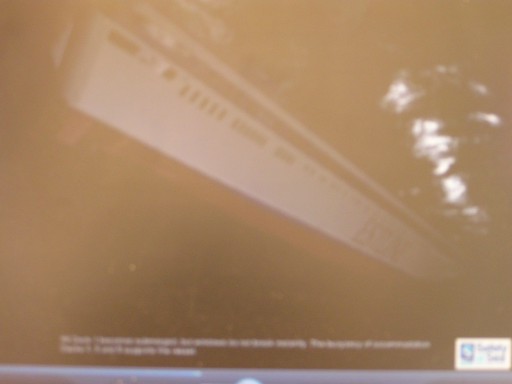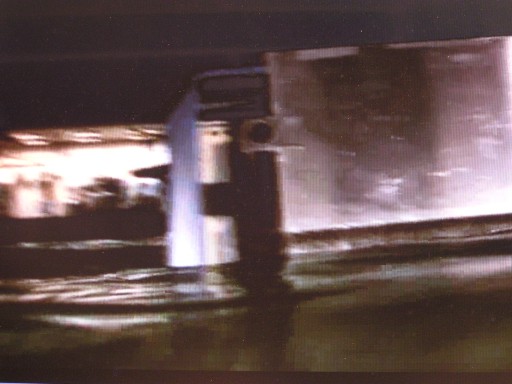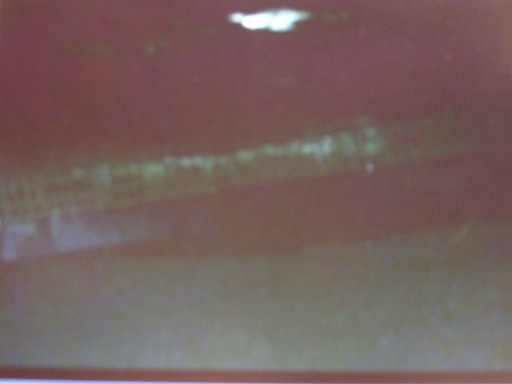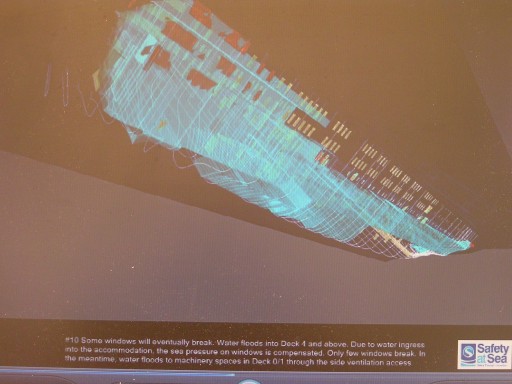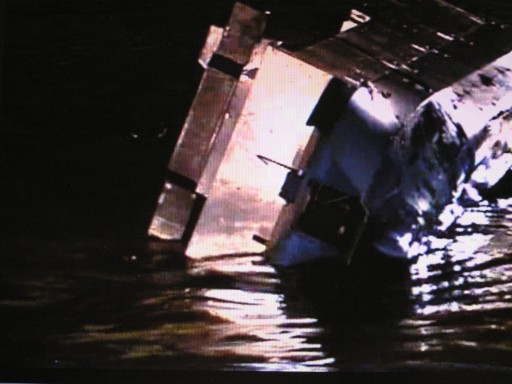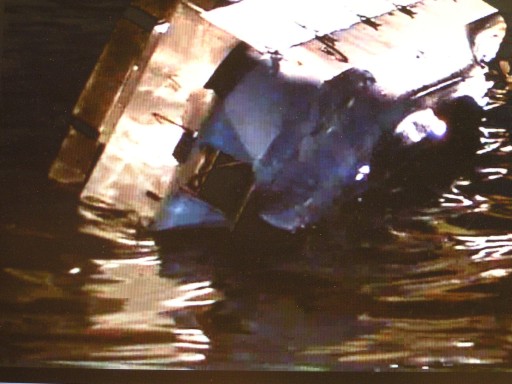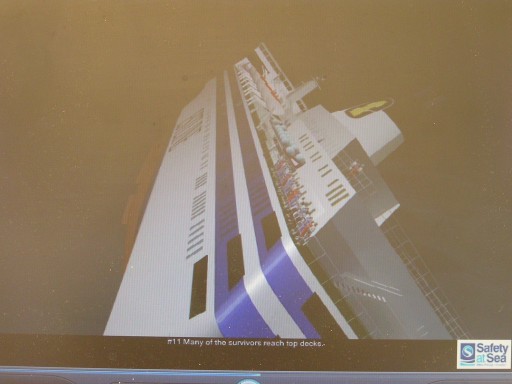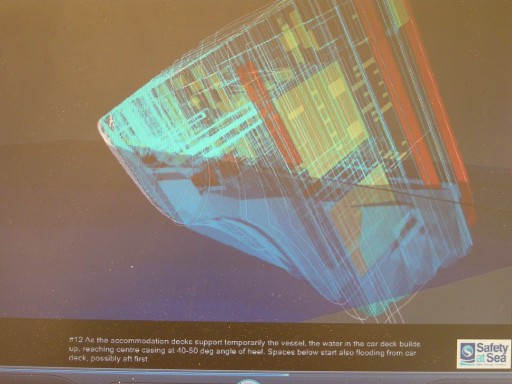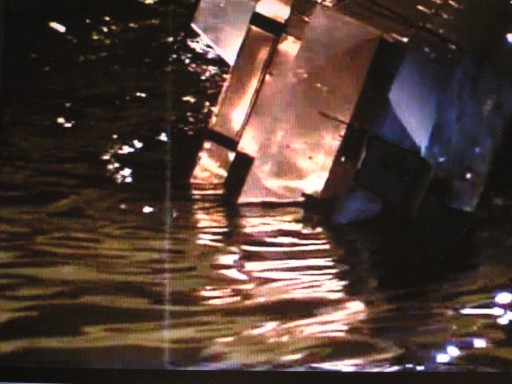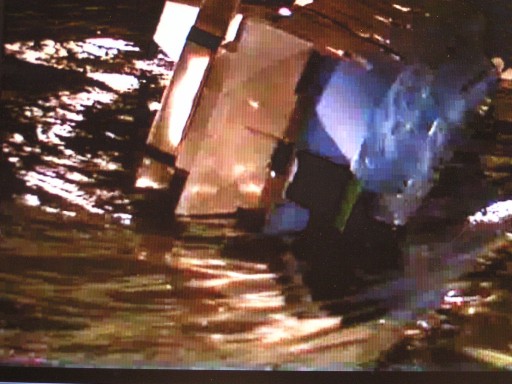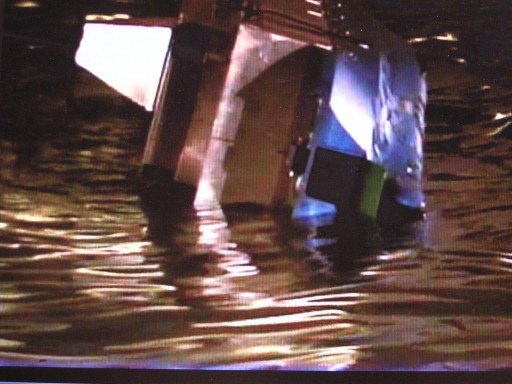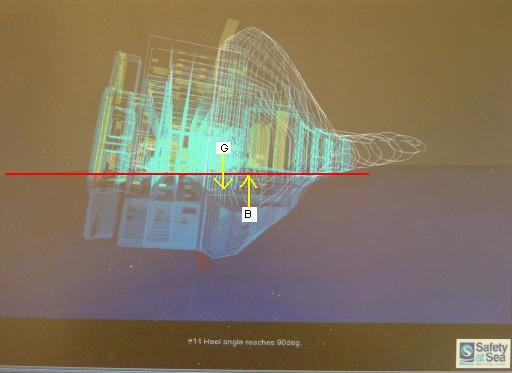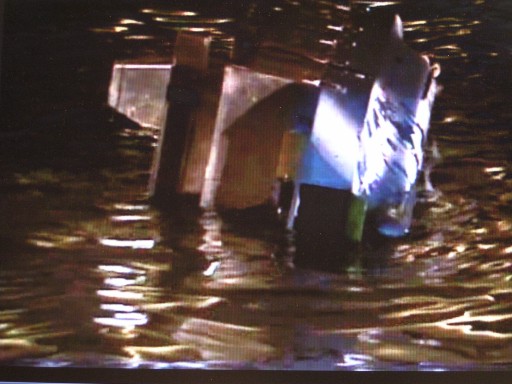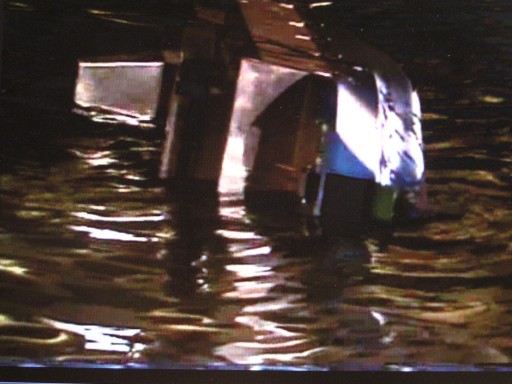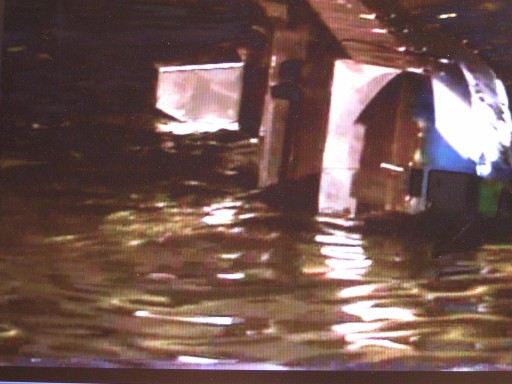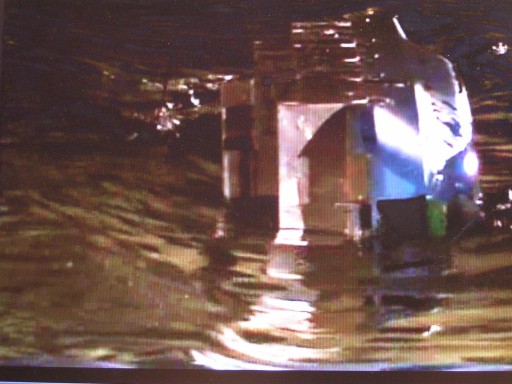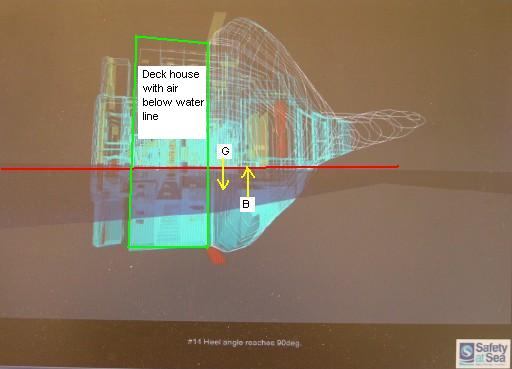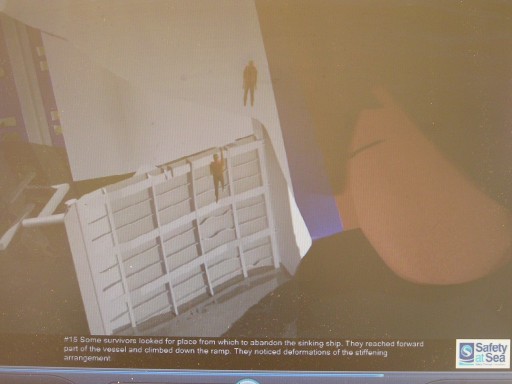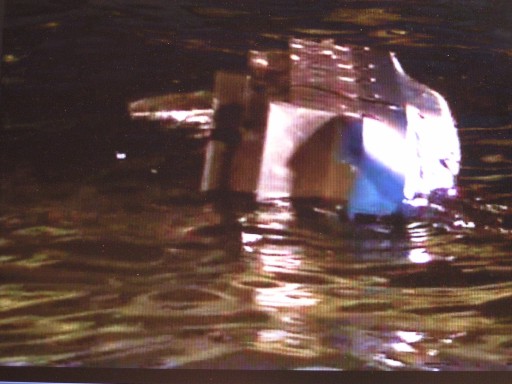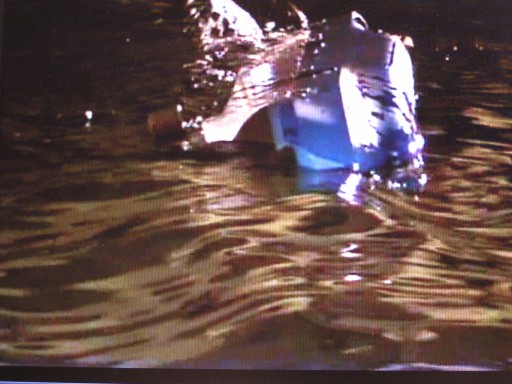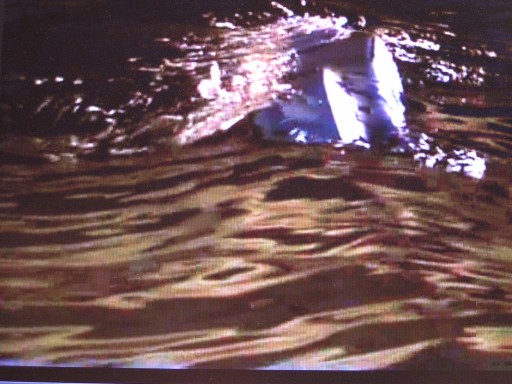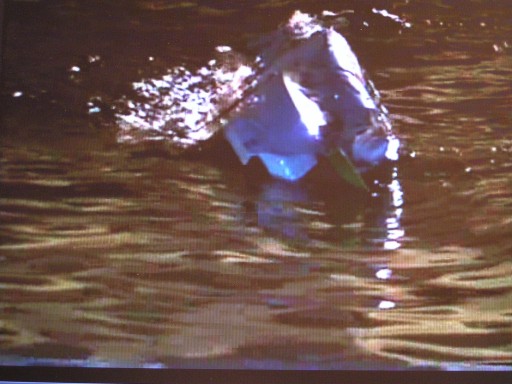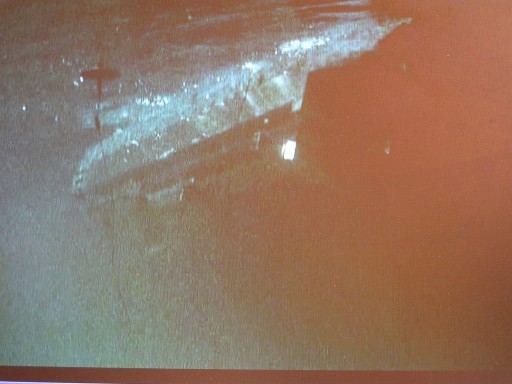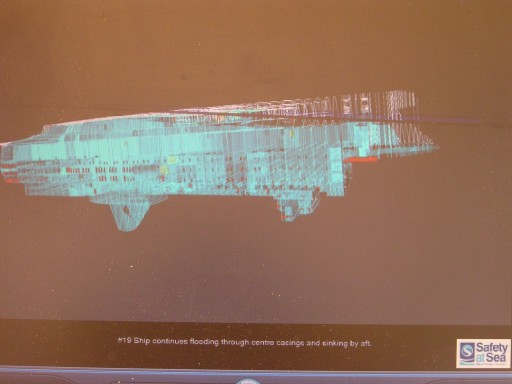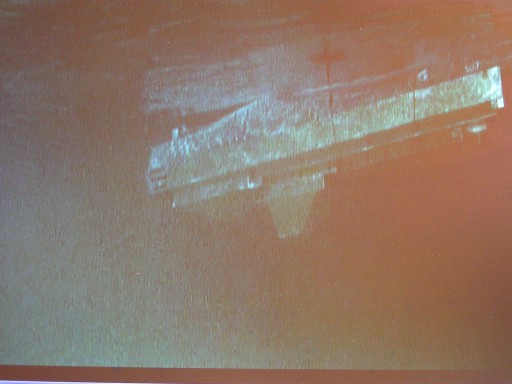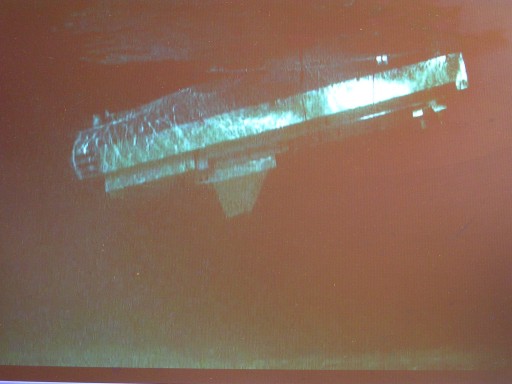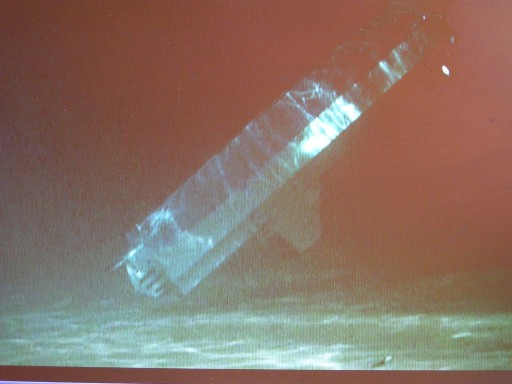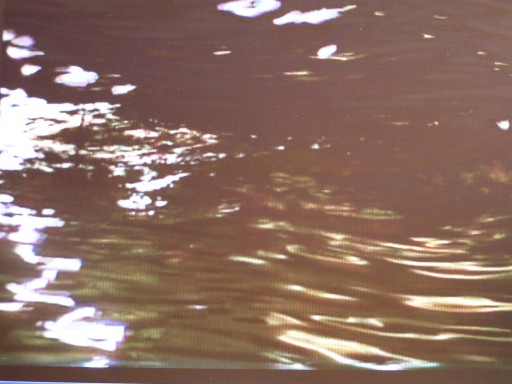|
|
The ultimate manipulation - how SSPA Marine AB of Chalmers University, Gothenburg, Sweden faked the model tests (to hide the true cause of accident!) as requested by the Swedish government (Mona Sahlin) The Vinnova (a corrupt Swedish state research agency) M/S Estonia sinking research study ordered by the Swedish government 2005 was completed with a public workshop at Stockholm 23 May 2008. The whole purpose of the studies were to shed light on the sequence of the sinking of MV Estonia but not whether exploding bombs were involved! The two research consortia (SSPA, HSVA) had submitted their final reports and supporting documents including videos of model tests and computer animations (1.000's of pages and 100's of MBs of cyber space) only one week before, so there was little time for anybody to seriously review them. I was not even informed about it. I got the data much later. SSPA says about its work: This report is the final documentation from the SSPA Consortium on the "Research Study on the Sinking Sequence of MV Estonia", which was funded by VINNOVA (The Swedish Governmental Agency for Innovation Systems) between March 2006 and May 2008 with 8.88 million SEK about one million Euros). The VINNOVA Registration Number is 2005-02852 and the SSPA Project Number is 4006 4100.
2017 no reports are available from these links and no writers include the reports in their CVs on the Internet. Isn't it strange that the final and complete documentation of a SEK 10 million research project is not available any longer? SSPA will not explain why. In the Summary we learn: It is concluded that the loss of 852 people on the night of 27/28th of September 1994 has resulted from a rapid loss of stability by MV Estonia. Therefore, all the circumstances and reasons for It is a very strange summary of the report. In 1997 it was concluded by corrupt investigators that the cause af the disaster was the bow visor falling off due to bad design and bad weather, which noone noticed, a bowramp was pulled fully open and that the superstructure (car deck/garage) was loaded with water (the hull was intact!) ... and the ship heeled ... and sank. No talk about breach of hull integrity or inadequate intact stability. SSPA says in the report that the main scenarios (causes?) considered were (combinations possible): 1. Bow visor falls off, car (superstructure) deck floods, heel angle increases, flooding (of hull) below through central casing, sinking with bow up (the JAIC scenario [1]). The purpose of the study was to explain the sinking of a ship with intact hull and closed watertight doors after the bow visor had fallen off and the bow ramp had been pulled open at 01.15 hrs and water was loaded on the car deck in the superstructure, so you wonder why SSPA considered 3, 4 and 5 a/b above about hull damage and 6 about superstructure side damage. Actually a one-compartment hull leakage due to collision or a stabilizer fin falling off would not sink the ship, as the ship could flood two hull compartments and survive. And leaking superstructure doors/ramps do not sink ships. The water just flows out through scuppers. One result of the report was, however, interesting (if it is true or not nobody knows): We were told that a model of the M/S Estonia, in conditions of the accident with open ramp, loaded 2 000 tons of water (full scale!) in the superstructure/garage in 150 seconds (full scale!) and heeled 37° during that time as shown below (note the Chalmers University logo to impress). Later 8 000 tons of water was in the superstructure - but the deck house (?) above was full of air providing buoyancy and preventing capsize: 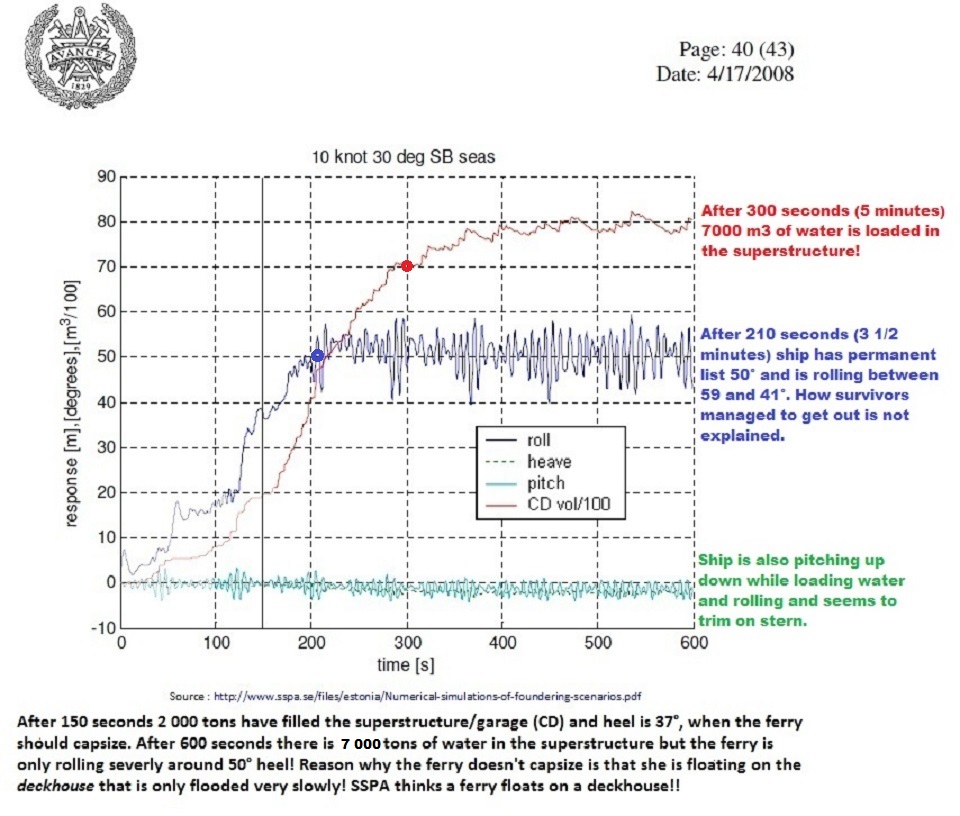 It means that nobody on the M/S Estonia would have had time to evacuate to open decks, because you can only evacuate, when the heel is <18°. And the heel was >18° after 100 seconds in the tests! But the ship didn't capsize! It was floating on the deck house! We are told! And then the deck house was flooded. In spite of this result the
scientific conclusions of
SSPA
and HSVA
are, of course, one and the same: Then the ferry was
floating on the deck house (!) for 22
minutes, when the heel angle slowly became 60,
70, 80 and 90° as per figure left (no. 37
of the SSPA Final report)! When the
Mayday was sent at 01.22 hrs the heel was
80° (and not 20-30° reported by the
officer sending the Mayday). But the up-side-down floating ship sank (!!!) during 18 minutes! Trapped compressed air providing buoyancy mysteriously disappeared from the hull, we are told! The accident took thus place as follows according Chalmers/SSPA: At 01.30 hrs the ship was floating upside down! And then it just sank during 22 minutes Nobody at the public workshop at Stockholm 23 May 2008 asked any real questions about all above. Reason being that it was not a public workshop! Only selected people were invited to applaud the show! Because, how could a ferry like M/S Estonia float on the deck house? The M/S Herald of Free Enterprise that capsized outside Zeebrügge 6 March 1987 never floated on the deck house: "When the ferry reached 18.9 knots (35.0 km/h; 21.7 mph) 90 seconds after leaving the harbour, water began to enter the car deck (superstructure) in large quantities. The resulting free surface effect destroyed her stability. But M/S Estonia behaved completely different, when capsizing 28 September 1994, it was announced at the public/secret workshop at Stockholm 23 May 2008: Only six aft windows of total 250+ deck house windows (2.4% !) in the submerged starboard side were assumed to break, when impacted by waves and submerged 10 metres below water at heel >45°. The M/S Estonia therefore first floated 22 minutes on air trapped inside the deck house!! Imagine that! The ferry M/S Estonia floating on air inside the deckhouse, when the garage was filled with 8 000 tons of water! It is called the Principle of Johan Fransson of the Swedish Maritime Administration. Ships float on deck houses. There is totally >110 m² of glass panes in the side windows and all should be broken and pushed in! But SSPA, scientifically, only allowed <1 m² of windows to break allowing a very small water inflow. JAIC on the other hand suggested 1997 that all windows on decks 4 and 5 were broken and that the deck house immediately filled with 14 000 tons of water! Capsize was however prevented according JAIC as the vessel floated on (undefined!) buoyancy in decks 6 and 7 (??) - deck house decks 6 and 7 were watertight according JAIC. SSPA changes the JAIC data but the result is the same. The vessel was thus floating (!) on the deck house and allowed to trim on the stern before heel exceeded 90° and capsize (sic) occurred … as shown in model tests and animations. And then the model floated upside down with several meters (full scale) of hull above water as seen below ... and slowly sank during 22 minutes! Photo: Bertil Calamnius The amazing result was all due to clever, intentional manipulations of the alleged scientific work of which all consortia participants and university boards were aware! Industry (IMO/SOLAS) safety standard is evidently that a deck house with or without windows does not provide any buoyancy at all at any time! A deck house is not water tight ... or air tight. It leaks like a basket. To demonstrate and suggest the opposite is intellectual dishonesty of the worst kind - to fool innocent survivors and relatives ... and everybody else! The manipulations are however very easy to see in the SSPA model test video at the consortia web site. If the link does not work try here! There is also a computer animation of the same event that differs completely from the model test. Some examples will be shown. One model minute is about three full scale minutes! Fig. 1 At time
00:20 - a wave sloshes against closed bow
ramp. Note that there are no
windows/openings in the port, white deck house
above the blue superstructure. Actually the model
deck house is made air tight on the port, forward
and aft sides, so that the model will not capsize,
when the deck house comes below
water! The manipulated model tests by
SSPA are good evidence that everything
JAIC stated 1994-1997 is wrong!
Evidently the Estonia did not sink due to a
lost visor + water in the superstructure. If that
were the case, there is no need to falsify model
tests 14 years later! MV Estonia sank due to
hull leakage below waterline as suggested by Heiwa
Co since September 1994. The model test video starts with
a 48 seconds sequence (00:06-00:54) with
ramp closed and 14 pitching bow movements
up/down as expected. You can see that the ferry
could have sailed without visor and closed ramp!
The waves just push the ramp aft against the
superstructure. In full scale it would take much
(about three times) longer! Full scale forward
speed is >15 knots! Fig. 2 At time
01:04 the ramp opens fully. Note
windows in starboard deck house side. Details of
the windows are not clear - are they open or just
painted ... or both? In the model test only two (!)
starboard deck house windows on each deck 4-6
aft (there are 250+ windows in each side)
are assumed to be broken allowing water to enter.
This has nothing to do with reality! A ship does
not float on thin window panes. At video time 01:04 the
ramp opens fully and water is loaded
on the car deck during about 25 seconds
(01:04-01:29 - model time) and 6-7 bow ramp opening
pitching movements below water and
the vessel quickly heels >20° to starboard
as expected. In full scale it would take
about 3 times longer or 75 seconds. After another 75 seconds the
ship should be upside down ... and loating on the
air trapped inside the hull! Fig. 3
Ramp opens in computer animation.
Note windows in deck house front. Computer
animation does not show the initial
heeling. The ramp opening is also shown
in the computer animation but no water inflow or
heeling, as the opening is above
waterline. Fig. 4 At time
01:24 abt. 100-200 tons water (full-scale) is
pushed into the superstructure, when deck 2 is
below the waves. It happens every 6-8 seconds
full-scale or 2-3 seconds model-scale and is a very
noisy event (if it takes place?). At every bow pitching
below water with fully open
ramp - it takes a few seconds in model
scale and 3 times longer full scale - 100-200
tons of water (full scale) is pushed into the
superstructure like a tsunami causing
an enormous noise! No survivors heard anything
like that. Evidently the water would
push cars and lorries on the car deck aft and
destroy the lighting system. But the Estonian
engine crew noticed nothing on their CCTV monitors.
The ramp was closed! Fig. 5 At time
01:50 vessel has just started the port turn and
more water enters on deck 2. The ramp is fully
open! At time 01:30 (80-90
seconds full-scale after ramp was
opened) the alleged turn to port seems
to be initiated and the vessel is slowing down;
more water is loaded on the car deck through the
open ramp when 16 more
waves are scooped up (01:30-02.31). Fig. 6 At time
02:18 the turn continues and vessel slows down ...
and more water has entered into the superstructure
and the deck house comes under water.
The ramp is
fully open! After 150 seconds model time the
heel (roll) is >40°. Two and a half
minutes in model time is about 7-8 minutes full
scale. Why not? But evacuation to open decks is
only possible when heel is <18°. Fig. 7 Engine
crew watches a closed ramp before the
sudden heeling in a ridiculous computer animation
picture. The actual event took place 2-3 minutes
after the heeling started so all people in ECR
should be at 40° or have fallen down to
starboard! And the ECR does not look like above!
The M/S Estonia is then heeling
>40°. Evacuation is then not
possible. Nobody can walk on a deck that is
sloping 40° (maximum is <18°).
All survivors have,
however,testified that the angle of heel was much,
much less (<15°) for at least 10 minutes
allowing >300 persons to reach open decks!
The development of the
heel goes much faster in the model test than
reported by witnesses. See also fig. 9
below. It is now, 2-3 minutes full-scale, 50-80
seconds model-scale, after heeling started that the
engine crew has gathered in the ECR and observes a
closed ramp according to JAIC! The
angle of heel is already >40°!! Fig. 8 Water
sprays in at forward, closed
bow ramp
at 40° heel. And nobody cares! The engine
crew remains another
6-8 minutes in the ECR - starts pumps, talks to the
bridge, etc. They do not panic in spite of
the big heel! In the computer animation
this event takes place much earlier - before any
heeling has started (!) and the floor/deck is
horizontal. They only see a closed (!) ramp with
some water spraying in. Actually - there was no
engine crew in the ECR before the heeling
occurred! The closed ramp was
observed 2-3 minutes after the
heeling/big rollling started and when the engine
crew had gathered in the ECR. According to the
model tests the heel is then >45° and the
ramp is fully open! The engine crew was in engine
room starting bilge pumps and trying to close
watertight doors! Fig. 9 Computer
animated passenger evacuation at <10° heel.
According model tests the ferry is never in this
position very long! It is now - heel is >40°
- the passengers start to evacuate. In the
Safety at Sea, Ltd, Glasgow, falsified
computer
animation evacuation
takes place when the heel is <10°; a
position that occurs during only 10 seconds in the
model tests. Fig. 10 At time
03:26 the vessel has stopped sideways in the waves.
No more water is scooped up through the
open
ramp
opening. If vessel pitches on the bow all water in
the superstructure should flow out! The computer
animation is quite
misleading. The model test video is then
interrupted (02:34-03:01) by a 'Model scale speed'
(?) insert. It seems to be some pictures of
water starting to flood the deck house through some
pipes? At 03:02 the video continues;
the model is then sideways in the waves, the
engines are stopped, speed is zero, the heel is
>45° and the vessel 'floats on the
deck house'. >110 m² of
windows in the side are not
broken! Fig. 11 Computer
animation of 35-40° heel. Center of gravity G
is above center of buoyancy B. This is the critical
angle when vessel would turn upside down. But it
does not happen in the model tests! This is not a stable condition -
there is no equilibrium and you would expect the
deck house* to fill up quickly with water,
the model to capsize - heel 90° and float
upside down with heel 180° within a few
minutes full-scale (the hull is full of 18 000
m3 air), but it
does not happen! It is now the manipulations
start! A deck house with thin window
panes is as watertight as a straw basket! Fig. 12 At time
04:13 the vessel drifts sideways in the waves.
Starboard side is facing the incoming waves. You
would expect the vessel to turn upside down =
capsize. As bow opening is above water and in lee
no more water enters. The ship is still
stable. Bur it is suggested water enter the deck
house aft. The bow ramp is open but
above waterline! The model deck house - all
spaces above deck 4 - is arranged so that the water
inflow is very small! There are no window
openings on the port (upper) side or in the front
or aft bulkeads of the deck house (!). Water enters
only through a few broken windows below water in
the starboard side aft to allow the vessel to trim
on the stern and later sink on the stern. This
manipulation provides buoyancy in the deck house
that does not exist in reality! Fig. 13 At time
06:24 the vessel has reached this impossible
position. It is not stable unless the white deck
house is full of air below water line! This is the
basic manipulation to prevent capsize. The
bow ramp opening is still above water
and no water enters there. So why does the ship
sink? Between say 06:00-11:00 the
model is heeling >60° sideways in the waves
and rolling totally >40° i.e. between
40° and 80° heel. Any survivors should have
experienced this as a roller coaster trip but it
never happened in reality. Evidently all windows in
the starboard side would be broken at this time,
but SSPA does not allow it. One reason for the
violent and unusual rolling is the behaviour of the
buoyancy in the deck house that will reinforce the
rolling! In reality there is no buoyancy in a deck
house. Fig. 14 At time 06:50 the vessel rolls severely. The bow ramp opening is still above water
Fig. 15 At time 06:54 the roll is maximum. The bow ramp opening is still above water
Fig. 16 At time 10.10 the vessel rolls severely. But it is about 10 minutes full scale time and the heel is only 60°. The ship should float at the side now! The bow ramp opening is still above water
Fig. 17 At time 10:14 the roll is maximum. Note the valve in the bottom! It can be opened to release air trapped in the hull to allow sinking! Fig. 18 At time
11:18 the vessel rolls severely. But the >4000
tons of water (full-scale) inside the
superstructure does not trim the vessel. The
bow ramp opening is still above
water. The water in the car deck should flow out
... There is >4 000 tons
of water (full-scale) in the superstructure and you
would expect it to trim the model, i.e. flow aft
(trim on stern) or flow forward (trim on bow) ...
and flow out. You wonder where the 4 000 tons of
water is? Water on the other hand flows into the
deck house only through broken windows aft and
trims the vessel on the stern. Fig. 19 At time
11:53 the deckhouse side decks 4-5 are permanently
under water. Two 'broken' windows aft are
indicated in the red ring. No water can enter
through the other 'windows'! Fig. 20 Computer
animation of the deckhouse side decks 4-5
permanently under water. In the animation the
windows are assumed not to break and there is
plenty of buoyancy in the deck house! In reality
all the windows should be broken. At time 11:53 the starboard side
windows of decks 4 and 5 are permanently below
water; windows of decks 6-8 are below water when
the vessel rolls down … but the water cannot
freely fill the inside spaces as inflow is
restricted to a few windows at the aft end
only. Fig. 21 At time
11:56 the deckhouse side decks 6-8 are under water
when vessel rolls. Fig. 22 At time
12.46 the deckhouse side decks 4-5 are permanently
under water. All windows
should be broken due to the severe rolling and
waves hitting the thin window panes, but little
water is seen flooding the deck house. In the model
test only two starboard windows on each of decks 4,
5 and 6 aft are broken! This is completely
unrealistic! Fig. 23 Computer
animation of the deckhouse side decks 4-5
permanently under water. Only a few windows aft are
alleged to be broken. It is suggested that the
engine room is flooded through narrow ventilation
trunks and that the flooding of the engine room
goes quicker than the flooding of the deck house.
There is no evidence for that! The deck house
should be flooded instantaneously and the vessel
should capsize and float upside
down! Same observations can be done
later at 12:30-14:00. At time 12:46 there are
underwater pictures of the whole
starboard side above deck 4 below water -
and you would expect the deck house to fill up 100%
with water! Fig. 24 At time
13:23 the vessel has reached this impossible
position. Capsize is prevented by air (buoyancy) in
the deck house. Model floats on the deckhouse! No
passengers on open decks could walk on the side of
the ship at this time 30 ful scale minutes after
first heeling. The bow ramp opening
is still above water Fig. 25 Only
reason why vessel floats at time 13:59 is that the
model deck house acts as an air tight life west
preventing capsize. It is a serious manipulation to
fool the public. The bow ramp opening
is still above water The vessel is rolling
20-30° around a heel angle of 60° and you
would expect all windows on starboard side to
break, when impacted by the waves allowing
a
substantial inflow
of water into the deck house. But it does not
take place! Flooding into Deck No 4, 5
and 6 could only take place through two (!) open
windows in the starboard aft part on each deck of
the model according to SSPA. So the model
floats on the air inside the deck house below
waterline! No capsize can take place as you would
expect. But the vessel trims on the stern due to
the water in the deck house. Fig. 26 The
computer animation evidently shows the windows in
the port side - but then the condition is
permanently unstable and the vessel should turn
turtle. In the computer animation this
position is shown in figure 26. Fig. 27 For this
animated condition with 40-50° heel to be
stable the deck house must be assumed to be full of
air below waterline. The designers of the animation
thus know that the model tests were going to be
manipulated and vice versa! And it is backed up with the
animation in figure 27. Fig. 28 Only
reason why vessel floats at time 16.06 is that the
model deck house acts as a life west preventing
capsize. The bow ramp opening is
still above water Fig. 29 Only
reason why vessel floats at time 16.26 is that the
model deck house acts as a life west preventing
capsize. The bow ramp opening is
still above water Between 13:13-25:10 the vessel
is floating with 80° heel angle sideways in
the waves and it is only due to water not being
able to flood the deck house! Fig. 30
Impossible floating condition at time 16:27. It is
now the engine crew crawls out of the funnel and
... climbs up the vertical deck 8 to the upper port
side. The engine crew was very agile! Climbing 10
meters straight up! The bow ramp
opening is still above water It is now the ECR
crew escapes and
arrives at the funnel ... and climbs up to the port
deck house side 10 metres above! All lies of
course! Fig. 31
Impossible floating condition of a ferry under any
circumstances!! A vessel cannot float like this!
90° heel! Center of gravity G is outside
center of buoyancy B and turns vessel uppside down.
Only by adding buoyancy in the deck house you
achive equilibrium. This is Hollywood (at
Strathclyde!). The bow ramp opening
is still above water In the computer animation this
unstable condition is shown stable as in figure 31
left. It would be interesting to see
the stability calculations behind the animation.
You need plenty of air in the deck house below
water for extra buoyancy there to achieve
stability! But such buoyancy does not exist in
reality. A deck house is not water tight. It is
flooded momentarily. Fig. 32 At time
22:16 the ramp opening is finally permanently under
water and the complete superstructure is flooded.
It is an impossible floating condition of a ferry
under any circumstances!! A vessel cannot float
like this! 90° heel! This is Hollywood (at
Gothenburg!). Fig. 33 At time
22:21 the model at 90° heel starts to sink
lower in the water. But the bow ramp
opening is still above water ... The ramp opening is soon
permanently below water. Fig. 34 At time
23:30 the model is still at 90° heel. It takes
time to flood the deck house as only two windows
aft per deck are open. Fig. 35 At time
23:34 the model is still at 90° heel. It takes
time to release the air in the deck
house. It is
now two Estonians climb down on the
closed ramp in other
animations ....
.
They then climb up again or jump into the water and
reaches a liferatf! See Fig 38
below. Fig. 36 Computer
animation of stable condition at 90° list.
Note that the starboard side broken windows are 10
meters below water - but the model still floats on
air/buoyancy in the deck house (indicated by a
green
frame) below waterline
(red
line). This manipulation shifts center of buoyancy
B below centre of gravity G to obtain equilibrium.
It is a criminal manipulation! Fig. 37 Only two
deck house windows aft per deck are assumed broken.
The vessel floats on thin window panes!
The condition at say time
23:30-23:34 is simply impossible from stability
point of view; 90° heel, bow ramp opening
continuously below water and the
superstructure full of water. Only
air below waterline in the deck house providing
buoyancy can achieve it! The flat starboard deck house
side is then 10 metres (!) below water full of
openings (all windows should be broken but in the
model test only two large windows in the aft part
on each deck 4-6 are open (!)) and the deck house
can then not provide any buoyancy for equilibrium!
It is only by wilfully (intentionally!)
preventing water to enter at the starboard bottom
side and the
air
(at least >15 000
m3
full scale) inside the deck
house to
escape that the model floats stable at this
time. If the deck house fills with
water
up to the waterline,
the vessel turns upside down very
quickly. Fig. 38 Computer
animation of stable condition at 90° list and
with brave survivors checking the bow ramp. This is
really Hollywood stuff! Fig. 39 At time
25:19 the model is still at 90° heel but the
ramp is completely below water indicating the car
deck superstructure is completely full of
water. In the computer animation two
brave survivors decide to have a look at the ramp
when the list is >90° and ship is rolling
severly! Imagine climbing down a ramp
at sea in the middle of the stormy night. Isn't it
crazy! Fig. 40
Schematic of cross section of Estonia at 90°
heel and draught d. G is the centre of
gravity/weight of the ship, B1 is the centre of
buoyancy of the hull, B2 is the centre of buoyancy
of the air below waterline in the deck house that
exists according SSPA. If B2 does not exist the
vessel heels to 180° (upside down) and floats
on B1 (above G) at once. The
violet
area is
the air column of height h in the deck house below
waterline that achieves extra buoyancy and a stable
condition at 90° heel. Normal air is shown as
yellow! h is also the solid water pressure head on
the windows at d below waterline. No window pane
can resist that pressure. All windows panes will
break immediately. A ship does not float on window
panes! MARIN has done model tests of
the flooding of the deck house between decks 4-5
only - but only at small angles of heel and with
two (!) windows open. And MARIN believes the deck
house is a superstructure*(!). The MARIN study is
part of the manipulations. *A superstructure is weather tight and no
windows are allowed and any opening in it must be
as strong as the steel enclosure preventing water
inflow. A deck house with thin window panes
is as watertight as a cane basket! No vessel
floats on a deck
house (except if it
is full of
air below the water
line)! It appears that the SSPA staff
arranged the model deck house by only a few
openings aft to prevent the deck house being
flooded instantaneously as expected when
submerged! It is very simple to demonstrate that
immediate capsize takes place in any model tank at
zero speed and no waves with the
existing model ,when the deck house is submerged. Just
provide some realistic openings in the model deck house
starboard side and aft end, so that water can flood
the deck house and some openings in the port side to
allow air to escape! Initially the E-model floats upright
but when 3 000 tons of water (full scale) is loaded on deck
2 to simulate flooding of it, the model heels >45°
and the starboard side deck house decks 4 and 5 come below
water and the deck house is flooded instantaneously and the
model continues to heel to 180° upside down (like the
MV Jan Heweliusz). This can also be shown by simple
animations, e.g. static stability calculations. Both
consortia assume and state the opposite - that the windows
do not break and that it takes 22 minutes to fill the deck
house through some small openings - to support a false
sinking scenario and provide manipulated model tests and
animations to this effect. It is not only
unscientific; it is criminal! Fig. 41 At time
25:31 the model is >90° heel and waves are
sloshing over the port upper side. When the model has abt. 90°
heel at say time 23:30, i.e. the port upper side is
horizontal and the ferry starts to capsize (!!)
90° to 150° heel without trimming. The
amount of air remaining in the hull at this
time decides whether the ship will float or sink
after capsize. Fig. 42 At time
26:49 big waves are sloshing over the port upper
side. Fig. 43 At time
27:13 is the last video picture of the model above
water. It is floating almost upside down.
Note the wide open ramp and compare with fig.
37. Big waves are seen sweeping
across the port upper side of the deck house until
27:13 when the model rolls upside down (the ramp is
still open (!) - it does not close) and after that
only underwater footage is shown; thus we cannot
see the underwater
hull now above water
to establish the buoyancy available. Fig. 44
Animation of vessel floating upside down.
Evidently no air can escape from the watertight
hull then and the ship should continue to
float. But by releasing air through a
hidden valve in the bottom the model
sinks. How the air - 16 822
m3
- trapped and compressed to <11 214
m3 inside the intact
hull below the car deck at this time
escapes is not known. In the model test it is
evacuated via two valves(!), one aft and one
forward, so that the model actually sinks due to
air/buoyancy losses. The explanation (sic) is that
this manipulation is required due to scale
effects! So SSPA first opens the aft valve and
the stern sinks. And then they open the forward
vent and the bow sinks. There is also 3 906
m3 buoyant material in the
superstructure and deck house to assist floating.
The weight of the vessel is only 11 930 tons (or
m3) so 3 191 m3 hull is
above waterline after capsize! Fig. 45 At time
28:47 the model is floating almost upside
down. Fig. 46 Photo of
model floating upside down in model testing tank.
It only sank due to a secret valve opened in bottom
releasing air! Fig. 47 Computer
animation of floating upside down. This is a
condition witnessed by survivors around 30 minutes
after the heeling started. There is no reason for
the ship to sink after reaching this position! Many
capsized ships have floated upside down like this
for weeks after capsize, e.g. Jan
Heweliusz. Fig. 48 At time
31:34 the model is still floating almost
upside down. The black buoy floating beside the
upside down hull was previously located on the
model and is now floating freely. It supports the
cable that is used to remote control the two valves
in the bottom of the hull to produce the
'sinking'. Fig. 49 At time
32:38 the model the stern starts to sink. SSPA is
releasing air trapped in the aft hull to achieve
sinking. Otherwise the model would never sink on
the stern. Fig. 50 At time
33:48 the model stern hits bottom. Later SSPA opens
a valve forward and allows air trapped in the hull
forward to escape so that the bow sinks. Quite
stupid manipulations,
actually. The video does not show the
hull above water after 27:13. You can maybe see the
air being released through the vent - like a whale
blowing out air? The model should evidently
have continued to float after rolling upside down
if the buoyancy of the hull (the compressed air),
superstructure and deck house exceeded the weight.
Or it would have sunk at once if the weight
exceeded the available buoyancy. SSPA has announced that they
allowed the air in the model hull to escape through
two valves (!). Otherwise the model would not sink
- a ship that suddenly capsizes upside down
generally floats ... upside down on the air trapped
in the hull, when buoyancy exceeds weight!
If the weight exceeds the
buoyancy, the ship sinks at once as per Arkimedes!
However the model stern hits bottom at video time
33:48. The model thus lost buoyancy aft first! Very
strange. Fig. 51 At time
34:37 the model bow disappears below the
surface. The video includes a few seconds
of the bulb at the bow still above
water. Actually the model should
drift upside down for twenty minutes full-scale
(8-9 minutes model-scale) at 2.2 knots speed to
reach the wreck position. It is not possible.
The video and animation are
nice pieces of pure propaganda and
misinformation! (It seems all Chalmers/SSPA
reports/videos paid for by Swedish tax payers are
no longer available on the
internet.)
|
